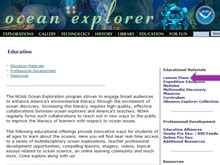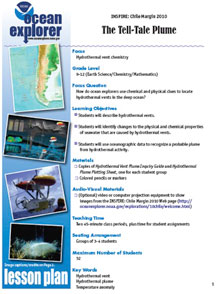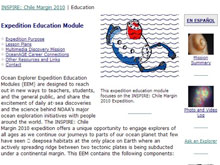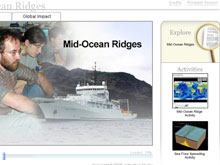Quicktime7 (H.264), 160x120, 1.3 Mb
Quicktime7 (H.264), 640x360, 22.8 Mb
Quicktime7 (H.264), 960x540, 41.6 Mb
Downloads:
Windows Media, 960x540, 19.8 Mb
MP3 (Audio), 7.1 Mb
Powerpoint Presentation, 78.2 Mb
You may need to download: Quicktime ![]() | Windows Media
| Windows Media ![]()
Part Two - Education

Slide 10:
Next, let’s click on Education from the top bar on the Home Page.
Slide 11:
The Education Section provides access to all of the online offerings provided by the NOAA Office of Ocean Exploration and Research. Here you will find access to Lesson Plans, Expedition Education Modules, Multimedia Discovery Missions, the Learning Ocean Science through Ocean Exploration Curriculum, a collection of educational materials focused around the NOAA Ship Okeanos Explorer, a number of onsite and online Professional Development Opportunities, ocean science career information, and additional resources. There is something here for every educator interested in deep ocean exploration.
We’ll go through several of these sections now. Start by clicking on Lesson Plans on the top right hand side of this page.
Slide 12:
Next click on Search lesson plans in the center of the page.
Slide 13:
You can search by key words or phrases for ocean exploration topics of interest, such as hydrothermal vents, cold seeps, plumes or deep sea fishes. Remember to always choose Adobe PDF format under File Type when you conduct a Lesson Plan Search using this search engine.
Slide 14:
Your search will bring up lessons specific to your search topic. In this case, we searched plumes and here are the results. On this page, find the lesson titled The Tell-Tale Plume.

Slide 15:
The Tell-Tale Plume lesson focuses on how water chemistry provides clues to the location of hydrothermal vents.
Each ocean exploration lesson is laid out in an easy to use format that includes:
- The Lesson Focus and Focus Question
- Grade level, Teaching time and suggested seating arrangement
- Learning Objectives
- Necessary materials
- Key words and Background information
- The Learning Procedure
- Assessment and Extensions
Remember: with a little creativity many of the ocean exploration lessons can be geared up or down to suit a particular grade level or audience.
Slide 16:
Each ocean exploration lesson is also correlated to the National Science Education Standards and many are correlated to the Ocean Literacy Essential Principles and Fundamental Concepts.
Slide 17:
Now go back to the Education main page, oceanexplorer.noaa.gov/edu/welcome.html, and click on Expedition Education Modules. This link is available in the column on the right and within the text of the main Educational Materials page.
Slide 18:
Expedition Education Modules, or EEMs, are designed as stand-alone education units to share the daily excitement of at-sea discoveries and the science behind individual major NOAA ocean exploration expeditions. Several EEMs are produced every year in conjunction with the annual ocean exploration mission schedule. If you sign up to be on the Ocean Explorer listserv you will receive announcements when new expeditions are underway and associated lesson plans are posted on the Web site.
Click on the expedition titled INSPIRE: Chile Margin 2010.

Slide 19:
Each module contains an Expedition Purpose, Lesson Plans, Multimedia Discovery Missions, Career Connections, and Other Resources and Links. In a moment we’ll talk about some of these elements.
Notice the name of the expedition in the links near the top of the page.
Slide 20:
It is important to note that EEMs can also be accessed directly from a main expedition page by clicking on the education link of an expedition in the left hand column. This is the main page of the Chile Margin 2010 expedition.
Notice that the items on the left and right side of this page are the same as on the previous page.
Slide 21:
Now let’s select the Lesson plans for the Chile Margin Expedition.
Slide 22:
For each EEM, lessons are grouped by grade level.
Slide 23:
For example, here are the lessons for grades 9-12 from the 2010 Chile Margin Expedition.
Ocean Exploration hands-on and standards-based lesson plans have been developed to bring entire classrooms on board for exploration and discovery. Using new technological eyes to see, sense, measure, image, and describe our little known ocean world, scientists and educators are bringing the excitement of late-breaking ocean discoveries into classrooms through the lesson plans presented here. Over 350 Ocean Exploration lessons are posted online in Adobe PDF format.
Slide 24:
We’ve discussed the Lesson plans and the Expedition Education Modules. Now let’s look at some dynamic learning packages called Multimedia Discovery Missions or MDMs.
Slide 25:
The 15 Multimedia Discovery Missions are each designed to be packaged lessons on particular subject areas such as plate tectonics, deep-sea corals and ocean currents.
Do you see one that interests you?

Slide 26:
Each MDM is comprised of Lesson and Global Impact videos with excellent background information, images and diagrams on the topic. In the top right hand corner, you’ll find a more in-depth interactive look at the subject matter. And, in the column on the right there are associated online activities for students.
These packages of presentations and activities are perfect for captivating different student learning styles. The videos are ideal to assist in teaching unfamiliar topics, and many of the activities are useful for assessing student learning.
Slide 27:
Now let’s look at the Curriculum link in the right hand column.
Slide 28:
Learning Ocean Science through Ocean Exploration is a curriculum for teachers of Grades 6-12 that takes lesson plans that were developed for NOAA Voyages of Discovery and the Ocean Explorer Web Site and presents them in a comprehensive scope and sequence through subject area categories that cut across individual expeditions. Each lesson focuses on an inquiry-based approach to teaching and learning and is correlated to the National Science Education Standards.
The curriculum themes are arranged in an order that progresses from physical science through earth science to biological and environmental science, as ocean sciences include all of these areas. This entire curriculum is available online and the curriculum book is provided to those that attend one of the onsite NOAA ocean exploration professional development workshops offered around the country through our alliance partners.
Related Links
Ocean Explorer Website Tutorial: Part One - Site Overview
Ocean Explorer Website Tutorial: Part Three - Okeanos Explorer
Ocean Explorer Website Tutorial: Part Four - Special Features
Ocean Explorer Website Tutorial: Full Video
NOAA Ocean Explorer: Education
NOAA Ocean Explorer: Explorations

